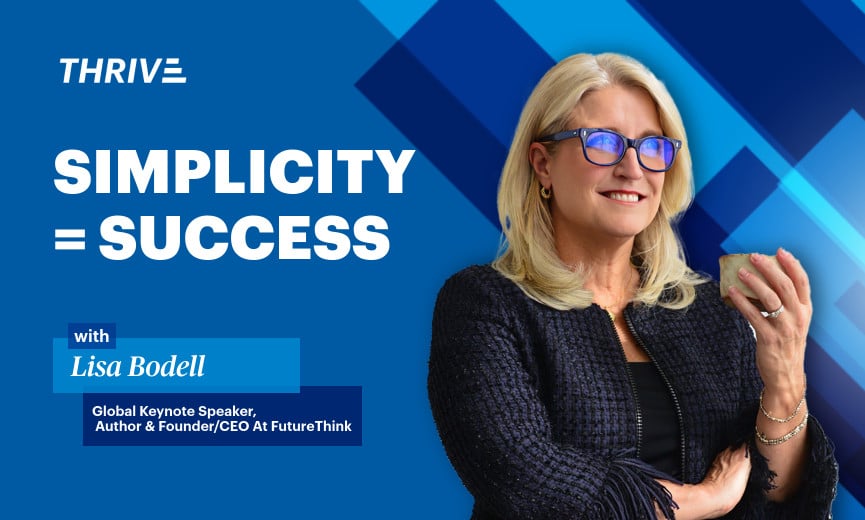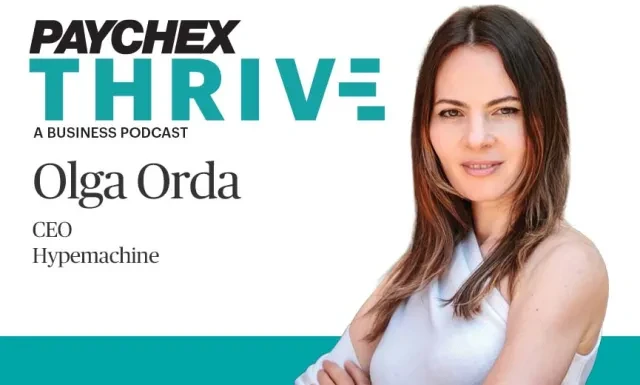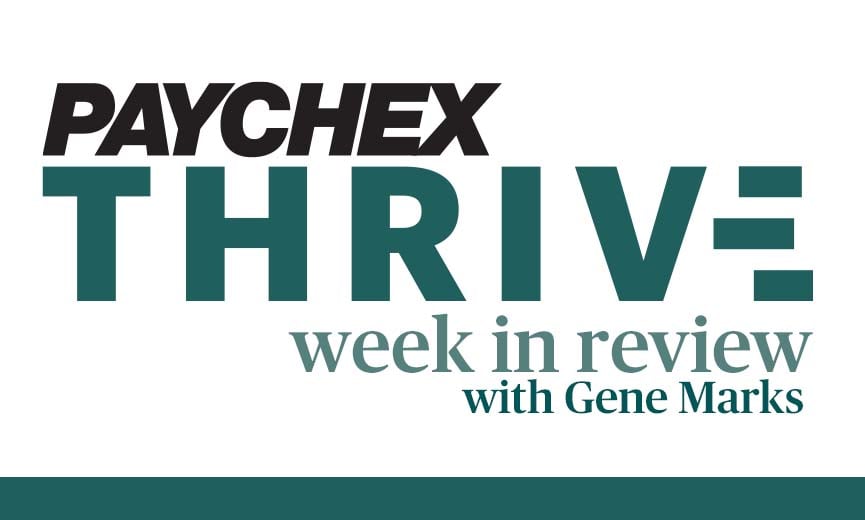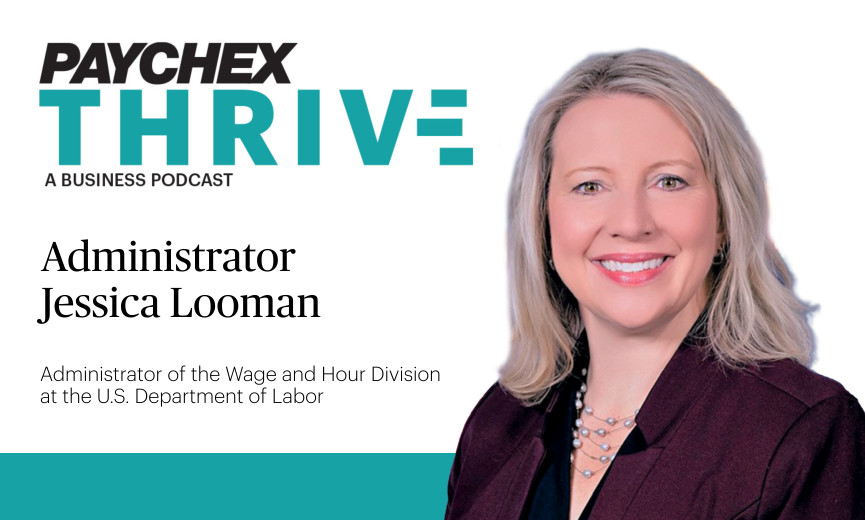Lisa Bodell, CEO de FutureThink: Cómo la simplicidad impulsa el éxito empresarial

Podcast •

Vea
Resumen
Is your business drowning in unnecessary complexity? This week on Paychex THRIVE, Gene Marks chats with Lisa Bodell, keynote speaker, author, and simplicity consultant, to discuss how cutting through complexity can boost productivity, foster innovation, and increase employee engagement.
Topics include:
00:00 – Episode preview and welcome
00:55 – Overview of Lisa’s work and clients
02:48 – Addressing email overload
04:27 – The process of simplifying an organization
05:54 – Role of AI in simplification
08:19 – Areas in business prone to complexity
09:06 – Simplification in different business sizes
12:00 – Good friction vs. unnecessary complexity
14:01 – Gene and Lisa talk to-do lists
16:56 – Surprising clients
22:17 – Measuring simplicity’s impact
24:10 – Tips for more effective meetings
24:58 – Wrap up and thank you
Connect with Lisa:
> LinkedIn
Connect with FutureThink:
> LinkedIn
Looking to simplify HR? Consider the benefits of outsourcing.
Learn how AI can help streamline the daunting task of recruiting.
Ver transcripción
Gene Marks (00:00)
Hey, everybody, it's Gene Marks. And welcome to another episode of the Paychex THRIVE podcast. Today I spoke to Lisa Bodell. Lisa is a keynote speaker who specializes in simplicity and innovation. She runs a consulting firm that helps organizations make their processes through emails, their meetings, and other things more simple for their employees. So, if you'd like your employees and your organization to simplify its processes and be more productive, you're going to learn a lot from this conversation. Let's go to Lisa.
Announcer (00:30)
Welcome to THRIVE, a Paychex Business Podcast, your blueprint for navigating everything from people to policies to profits. And now your host, Gene Marks.
Gene Marks (00:43)
So, Lisa, thank you very much for joining me today. I'm thrilled to have you on.
Lisa Bodell (00:47)
I am thrilled to be here. Thank you.
Gene Marks (00:49)
Sure. So. So first of all, you know, you're a keynote speaker, you're an author. Your book is Why Simple Wins. Tell me a little bit about how you got here. How do you make money?
Lisa Bodell (01:00)
How do I make my money? Well, part of it is the keynotes in the books, but yeah, I run a skill building business. And so, the idea is, how can we help people actually become more simplified at work? So, my team goes in and there are a bunch of improv fun people that go in and teach those skills. And then we also have an on-demand business for people that are like on the go and want to watch on the train or listen in the car so they can learn how to simplify in little ways every single day. That's how it makes money.
Gene Marks (01:26)
That is a bit. Okay, so give me an example. I mean, so say you go into a client, like, first of all, you go to organizations and I'm assuming they're of most any size. What? You know, why do people hire you? And give me an example of like, what kind of stuff you guys do.
Lisa Bodell (01:41)
Yeah. So, you know, it's interesting because they come to us when they are drowning in complexity.
Gene Marks (01:45)
Okay.
Lisa Bodell (01:46)
And it's come to the point where it's just become so calcified, it's hard for them to get anything done. Despite their best intentions. They ask us to come in. They know they have a problem, but they don't know how to solve it. We come in and help them eliminate the unnecessary complexity. That's important because some complexity is necessary for safety reasons. Then we help build it into the culture. An example would be they would come in and let's use Fidelity. We've worked with them as an example. They say we are drowning in complexity. We would run a Kill a Stupid Rule so session across the entire company, we would do a diagnostic to understand where the complexity happens. Because maybe it's email, maybe it's decision making, right? It can be surgical about it. We would kill all the rules possible, that people have assumptions around why it's so complex or why decision making has to happen the way it does and teach them those tricks. And then we start to embed it into the culture, like teaching them, you know, to not just reward people for more, but for less. So how do you build subtraction into the culture? And there's ways to do that.
Gene Marks (02:48)
So, you know, let's use the example of the email. So, first of all, you know, maybe you can use Fidelity as an example or another client, but everybody has those issues with email, you know, and it's just being too much and too complex. And you know, what, what kind of suggestions do you make? And then how do you make sure that those suggestions are actually implemented?
Lisa Bodell (03:07)
Well, and there's an important note on that, which is it's one thing to put those tactics in place, right? But that's why I mentioned the culture, because, like rules and habits, they're like weeds. They grow back. And so, you've got to teach ways that you can actually do this stuff over time. So, with emails, for example, is the problem, and this is what we diagnose, is the problem that there's too many of them? Is it volume? Is it length? Like, people just send terrible long emails. Is it frequency? There's lots of different things. Is it not knowing a clear ask? So we help them. For example, one of the things you can do is you can type into your subject line an NNTR, which stands for no need to respond. And that cuts down, you know, people sending back those empty calorie emails to you dramatically between 10 and 20%. It's astounding how much like empty calorie emails there are. Another one you can do is called bluff. And bluff is interesting because it stands for bottom line up front, and it teaches people to get to the point. And for every email you send, you write bluff and the point of the email and then the rest of it underneath. And it forces people to think through, what do I really want to say and why am I sending this in the first place? You'll probably cut down on the amount of emails you send because you realize it could be a phone call or a text. It doesn't have to be an email.
Gene Marks (04:21)
Keep going, that's good.
Lisa Bodell (04:24)
That's it. That's small ways to do it.
Gene Marks (04:26)
First of all, that's great. If you're working with a large organization though, I'm assuming you work with departments or you know, you know, different parts of organizations. But it sounds like it's a lot of training and you're changing a lot of bad habits.
Lisa Bodell (04:41)
Well, here's what's interesting though. It's not a lot of training, it's just teaching people the technique and making them and, and showing them once how to do it. So, for example, you don't have to do multi days of training on killing stupid rules. People get it right away. They just don't realize that they're able or have the permission to do it because we don't think like that.
Gene Marks (04:58)
I really love that. Do you, you know, are your engagements you're relatively long term? I mean, they're not. So, you go in, you'll, you'll identify the areas where people are overcomplicating things. I love using email as the example because we can all identify with that. And then you say like, okay, well you know, you should be composing emails in this way or doing it in that way. And then you're just like, go now. You know, we've told you what you need to do now go and do it.
Lisa Bodell (05:25)
Sí.
Gene Marks (05:25)
And that's the extent of it. Is that correct?
Lisa Bodell (05:28)
Well, you always need to go back because I always say like, rules are like weeds, they grow back. And so, you know, that's the kind of thing you want to build into your system every quarter because with the best of intentions we put more things in place, and you have to constantly weed the garden. So, there's, there's certain things that you should make systemic and there's other ones that are just good habits to embed into your daily work. Like the NNTR and the bluff stuff. That's the idea. But you know, we're a simplification company so everything that we do needs to be short and accelerated and sweet and something that people can do on their own.
Gene Marks (05:58)
Staying on the topic of emails, does AI worry you? I mean, can't chat GPT make similar recommendations? Can't there be you, you say to an employee, okay, listen, you want to simplify your emails, put this into ChatGPT and simplify it for me and then copy it back into an email. Does that, you know, how does AI play into this? Or do you think you'll be incorporating it in the type of consulting that you do?
Lisa Bodell (06:21)
You incorporate it. So, you know, AI is a fantastic productivity tool. I mean, we do literally hundreds of videos for LinkedIn on productivity. And they all, I would say the large majority of the most recent ones have to incorporate some kind of tip around how to use AI to facilitate that productivity. The one thing AI doesn't do right is it can't help you really create the habit. It can give you the information and it's not good with context. So, you know, you have to be very good at teaching prompts. So, we teach curiosity as well. And so, you know, the people that are going to win search is going to go away. I mean, pretty, you know, 10 years from now, if you still have Google, I'd be stunned. But you're going to, you are going to use AI to supplement your work and replace the things that are rote and repetitive. So that's going to free up a lot of time for you to think and be more creative, which is great. So, I want to help people get rid of the stuff that's getting in their way so they can use AI to think and be more creative.
Gene Marks (07:17)
Can you give me another example? We talked about email. What else when you go? And you don't have to give away the form here because I, you know, you've got a service to sell. I, I'm, I'm curious. Tell me some other areas when you go into organizations, both big and small, where you're like, these people are always doing this, always need help in this area.
Lisa Bodell (07:37)
I would say, like, one of the things we do is we, you know, we have a diagnostic that we put people through and once you understand where the problems are, like whether it's EMR meetings, for example, that's the kind of thing you could feed into ChatGPT and say, give me 20 suggestions or based on what I've shown you in this process, give me suggestions on how to streamline it. So that is something where AI could help you do that. And we actually tell clients how to prompt them to get that correct.
Gene Marks (08:02)
That's great. Is there other areas within a company where they're just not simplified enough? Is it the way they're conducting meetings, the way they're doing quality QA or QC, the way they're doing a manufacturing process, the way that projects are managed or delivered? There's lots of ways for humans to overcomplicate different things. And I'm wondering if you see any ones that are more predominant than others other than, say, emails or over-long meetings.
Lisa Bodell (08:30)
The obvious, the usual suspects are things like meetings and emails and processes.
Gene Marks (08:35)
Right.
Lisa Bodell (08:35)
Because we always, those get Frankensteined. But the ones that are less obvious are the things that are like committees, reports. And probably one of the biggest ones is decision making. And if you can help simplify decision making and complicated decision making is usually driven by, you know, an allergy to risk and fear. So that's actually changing behavior. See, like, people have to know if I actually take this risk, if I actually simplify this thing and get rid of something, I'm not going to look dumb, I'm not going to be in trouble, I'm not going to get fired. So that's where I say that AI can't do that. I can help change the behavior. But then we give them the techniques to actually streamline their decision making and empower people. That's what simplification is, is empowering them to make those changes and those simplifications.
Gene Marks (09:21)
This seems more like a big corporate thing than a small business thing. Am I right?
Lisa Bodell (09:26)
No, wrong.
Gene Marks (09:27)
Tell me why.
Lisa Bodell (09:28)
Well, because we're human and with the best of intentions, right? We have this in our culture, being busy is rewarded. We are slaves to our calendar. In fact, most of us aren't managing. We are executing our calendar every day. So, we have a hard time saying no. And we seem to confuse that being organized is being simplified, and those are different things. So, there are people that are very organized, but they will spreadsheet the hell out of something. And so, a small business, let's take mine. I am 20 people, I'm in New York City, and every quarter I run, I'll use the example again, a Kill a Stupid Rule session with my team, and then we kill zombie meetings. Zombie meetings are things that are repetitive on the calendar that have outlived their time with the goal. You have to know your goal of getting time back. And what's fascinating about it is this, you know, as a small organization, we have stupid rules. When I ask my team every quarter, when we get together to kill super rules, it's their favorite exercise by far. They look forward to it because I've given permission. Like they're just, they're excited. Most of the rules that they suggest to kill are mine, always right, because I, I put them in place of the best of intention and I know it's working when every quarter it gets harder and harder for them to come up with ideas of things to kill. So there, you know, it's easy to measure because you can see engagement, you can reduce burnout and people have time to do more things that matter and less things that are just busy work and the work of work.
Gene Marks (10:57)
How does remote work and work from home figure into this. Does it complicate the job that you do?
Lisa Bodell (11:05)
Yes, and it can, I think, in terms of communication, because the good news was technology... I just did a keynote for Zoom. It's funny. Zoom, the company. And, you know, they are a facilitator of meetings. In fact, the thing that makes them so good is that they make setting up a meeting frictionless. And I was laughing with their executive saying, I think a lot of people wish you made it harder to schedule meetings because it's too easy. So, people just do it, right? They just. Yeah, just click a button, invite everyone. They just want to get rid of it, so they accept it, and they don't even know why they're doing it. So, I think technology has helped us and hurt us in that way and in remote work, spurred a lot of that on, because the only way to connect is through a meeting.
Gene Marks (11:45)
By the way that is such a great point. When you think about when you set up how easy it is to set up a Zoom or a Teams meeting.
Lisa Bodell (11:52)
So easy.
Gene Marks (11:52)
And you think, like, you take the opposite approach. You say, make it tough. You know, before you set up a meeting, you have to, you know, your participants have to answer 10 questions or something.
Lisa Bodell (12:00)
Right, exactly. Laugh, don't laugh. I think that's actually a really smart suggestion. It's like you have to fill out this form, and I'm making it more complicated. But there's, you know, there's good friction. There's necessary complexity. My job is to get rid of the unnecessary complexity. And that's defined as invisible work. Stuff that has no value. But there's necessary complexity and necessary friction that makes people slow down, think, and be safe. And so, it's important to know the difference, because if you tell people to get rid of complexity, one that, especially if they're at, like, a pharmaceutical company or they work in intelligence or what. Right. You have to give them those boundaries because their first reaction is to go to fear. Sure. But once you have the boundaries, or what I like to call the guard rails, people go to town. They have so many suggestions of what holds them back. Or what we call time sucks. When you phrase it like that, the fear goes away because they're like, oh, time sucks. Oh, yeah, I can tell you what to do with that. So, words matter.
Gene Marks (12:59)
I'm sure if you ask people about what, you know, what sucks out most of the time, people at most organizations will say that meetings are driving. I mean, you should see, whenever I meet with these guys at Paychex they go from, they go from meeting to meeting to meeting, you know, like every big company, you know. Yeah.
Lisa Bodell (13:13)
And I like to say, congratulations, you're like everyone else. And I mean that in a comforting way.
Gene Marks (13:17)
Right.
Lisa Bodell (13:17)
I mean that in a good way. Like, you're not alone.
Gene Marks (13:19)
Right.
Lisa Bodell (13:20)
And there are things you can do. The key is in your sphere of control. So, if you want to make a difference, let's say I'm working with. No, I work with Novartis and Pfizer. And you're talking to them, and they'll say, oh, yeah, but you're not going to change the FDA or regulations. And I say, I'm not talking about that. That's not what we're talking about here. Why would you. You're beating your head against a wall. We're talking about within your sphere of control, the work your team does every day, that's where you want to get your hours back. Because, you know, when I ask you what you spend your day doing, let me ask you, if you have to tell me a list of tasks that you spend typically every day doing, what would you say?
Gene Marks (14:01)
I actually have like a list of tasks in my CRM system where I have a whole bunch of follow ups that I do. Emailing, different people, calling different people, reaching out, you know, that kind of stuff.
Lisa Bodell (14:10)
Email, phone, outreach. Okay.
Gene Marks (14:12)
You know, because I do, I do a lot of business development work and sales work. As you know, my 10 people in my company, we sell CRM systems. We use one of them. But you know, I'm constantly out there checking in on projects, checking projects, that kind of stuff. So, you ask me what tasks do I do during the day. I, I literally have a list of tasks in my CRM that I work off of every day. Right. That needs to be simplified, Lisa. Right.
Lisa Bodell (14:36)
Well, we're slaves to our to-do lists and our calendar. And at some point you can, you know, the idea is how do you have more compass and less clock?
Gene Marks (14:43)
Sí.
Lisa Bodell (14:44)
Sí.
Gene Marks (14:45)
And I mean, but you know, it's funny, there's different people have different personalities. Like, I have a lot of tasks that I do during the day on my CRM system. You, you said we have to-do lists. In addition to those tasks, in my CRM system, I have a separate to-do list of like overall things that need to get done that are not in my CRM system. And Lisa, you're going to think I'm an absolute lunatic here, but like the night before I make another to do list of just the four or five things I need to get done the next day. So, I've got like the next day's to-do list. I've got the overall to do list which sometimes overlap, of course. Right. And then I've got on the to-do list is my tasks and my CRM, but I have to get in there because I've got 40 follow ups to do today for people that are sitting on quotes or people that I need to get back to or, you know, whatever. That's all. That's like, what's nuts, isn't it? I mean, I'm going to tell you something though, that sounds complex, but I get through it, man. You know, like, it's like a, there are some people that are just, you know, you give a busy, you want something done, you give it to a busy person. I do get through it. I'm sure you meet types like that as well.
Lisa Bodell (15:49)
Yeah, like, go ahead.
Gene Marks (15:53)
No, you were gonna say...
Lisa Bodell (15:56)
You know, I'm the person at the end of the day where if I've got stuff done to make myself feel good, I love a good to-do list. I will recreate my to-do list and then just knock stuff off to make myself be like, that's a dopamine hit, right? But yes, yes, because I, I do the same thing. Like I have my, this is my remarkable tablet, right? I've got my to-do list. But then I have my today's to-do list. I do the same thing because you know, we get sucked up in the difference between priority and urgency. Like this is my priority list. But then an urgency list takes over or it's the things that I can get done quickly to free up my headspace. For, for me it's writing or presenting. You know, I have, I'm on video a lot, so I can't, for me, I can't do those things until I clear the decks. And so, I try to time block as much as I can so I have the... I'm not context switching all the time. That's what it is for me. It's how do you best protect your time for thinking? That's really what it comes down to. Otherwise, you're a slave to your to-do list. Right?
Gene Marks (16:56)
When you meet like a prospective client, you know, who is that client, where you're like, these guys, I'm gonna, I'm gonna crush it with these guys. I know they can use my help and this is gonna be a great project. And by the way, I think that all the time with my clients and I'm wrong about 80% of the time because I'm a terrible judge of people. But let's just go on. From your experience, even when you look back, you know, like, who's like the type of client... And I asked this because people that are watching or listening to this who are interested in working with your, simplifying their, their businesses and their lives, do, do they qualify or they, would they be a bad client? You know who are the best ones?
Lisa Bodell (17:32)
I think the, well, let's put it this way. The best ones are the ones that will surprise you. But you know, clients that aren't good are the ones that are, they're, they have fear. I can go in and I can make an impact immediately and get you hours back, but you don't go in and do it. Let's say a Kill a Stupid Rule. You don't go in and do a Kill a Stupid Rule session and then have the boss say, no, no, no, we're not going to get rid of any of those. That is a complete waste of time. And that's, we have to vet that because a lot of times it's the. I want everyone else to do it, but oh no, I have to make a decision. No, we're not going to do that. So those are the bad ones. The good ones are. It's interesting. Most, I would say are because it's agnostic. It goes across, it's human. Right. So, it goes across every type of industry. The more regulated the better because they are especially drowning in things. And the people that will surprise you most that are really good at it are lawyers.
Gene Marks (18:33)
I have the opposite experience. Why do you say that lawyers will surprise you the most?
Lisa Bodell (18:36)
Well, because most people think they're the department of no and they're the department of yes if. Yes, you can, if you do this. So, you know, they're tired of being the bad guys. Sometimes they are, most times they aren't. You know, they're just trying to mitigate risk. But they are all in on helping you simplify language, simplify contracts, do all that stuff as simplified as possible.
Gene Marks (18:57)
Right, right.
Lisa Bodell (18:58)
And that's where they are very good at not seeing extremes. They're seeing the guardrails. So, I enjoy working with the lawyers because I think that they, they want to be heroes, not hate it.
Gene Marks (19:11)
Lawyers are good prospects for you as well because they're just by nature extremely busy and they're constantly looking at ways they can improve their productivity so they can have better work-life balance.
Lisa Bodell (19:20)
Yeah, they are.
Gene Marks (19:21)
So, yeah, I could see that. And it's funny too, because I have clients that they're busy, busy, but they're playing golf a few times a week or coming into work at 10 running businesses. You know, lawyers are not like that. They are definitely more at a level of stressed out. They're terrible for the CRM systems we sell, but that's a whole other, whole other topic of conversation which is awful because they don't want to share any of their data. It's just, it's a mess. And by the way, so let me, let me tell you the kind of client that I look for because I'm curious to hear what your thought is when you're talking about, you know, adopting. I actually look for... You mentioned the, the boss. That's like, well, everybody else could do it, but I'm not going to do it. You know what I mean? Or like, okay, I realize all of your suggestions, what we should do, but nah, that's not going to work. We're not going to. My, my biggest thing is like, if it starts with the top, right? I mean, you know, you go to a client and I'm assuming somebody hires you that's at some managerial level and you need that person if you're going to come back and say you need to be running meetings this way, you need to be changing emails in this way. You need to be, you know, changing your process in that way. You need your client, the leader, that team to be like, I hear you, I got it. And that's what we're going to do. Right? No ifs, ands, or buts. Is that...what are your thoughts on that?
Lisa Bodell (20:30)
And they need to model it.
Gene Marks (20:32)
Okay.
Lisa Bodell (20:34)
The example of Albert, who's the CEO at Pfizer, I like to tell this story. We work with Pfizer. So, they, well, what was interesting was when he was the Head of Innovation and Simplicity with the best of intentions, he said his teams were drowning in meetings. And so he told people, just say no to meetings. I mean, that's great, right? He gave permission and so people feel empowered. And a month later, he noticed everyone was still going to meetings and he was kind of pissed off. So, he talked to his Chief of Staff, who he had a good relationship with and said, what's going on? And the honest answer was, well you still say yes to all the meetings. And if you don't do it, they don't do it because it sends the wrong signal. Right?
Gene Marks (21:20)
So true. And it's funny that you say that because we, we've implemented systems with the same way where, you know, and the other thing is like the weakest link. You know, what if, what if you have an organization, you're trying to make things more simplistic, and there's one key assistant manager or somebody that's reporting into your client that that one person doesn't want to do it. You know what I mean? Like, no, I can't with my team. It's not. That's not gonna work with my team. It's kind of like the weakest link, right? Because then when other people say, well, that guy's not doing it. Why should we be doing this? Right? That's gotta be an obstacle to you as well, correct?
Lisa Bodell (21:51)
Well, here's the thing, though, is I will say this with simplicity. It's contagious and it evokes jealousy in a good way. And what I mean by that is that people say, well, how come they get to do that? Why can't I do that? And the answer usually is, no one said you couldn't. You just didn't think you could get rid of things. So that's a positive thing. It's very rare that people push back and say, I don't want to simplify. That's not a thing. Really.
Gene Marks (22:17)
So many more questions for you, but we're running out of time. This one comes to mind and we'll see if I have another time for another one. But how do you measure what you do? You know, how do you go back to a client and say, we accomplished our objectives? It seems like a very difficult thing to measure that you've made things more simplistic. Tell me why not?
Lisa Bodell (22:35)
Not at all. You can. I mean, it's very easy in terms of. I'll use the Pfizer example. In an hour, we killed hundreds of rules, and they estimated that they saved a quarter million dollars just by some of the things we got rid of. So, it is very quantifiable in terms of hours and time. But the bigger thing that you can quantify is in terms of, in your employee engagement survey, increase in ability to get things done. Engagement, it increases employee engagement. It reduces burnout by up to 50%, and that's huge. You increase your trust in management. They are 95% more likely to trust their leaders. If you are transparent. Because simplicity is not just getting rid of things, it's being clear and transparent about things. So it's estimated that 10% of your profits are sucked up, wasted because of complexity. So, it is not... It's an easy sell to get money in time. But the human benefits, in terms of engagement, people don't leave their jobs, they're less burned out. That is actually just, if not more important. And I mean, the numbers bear it out. It's not just about productivity. It's about meaningful work.
Gene Marks (23:47)
That's great. Better work-life balance and being happier at work. Happier employees.
Lisa Bodell (23:51)
All of it.
Gene Marks (23:52)
Right. That's great. Final question. We talked earlier on. I mean you said the, the most popular areas, emails, you know, making them simplistic meetings as well. I never really, I didn't ask, so I apologize. But I'd love our audience to walk away, give it, give us a few tips on making meetings more simple.
Lisa Bodell (24:10)
Sure. I mean, I think I talked about getting rid of zombie meetings. I mean, people just don't realize that they can say no to meetings. So, I think what we need to start doing is getting boundaries around our meetings. Know what you're going to say yes with intent and say no with intent as well. I think a couple things. One's audit your zombie meetings. Two, put them on a time diet. So, by time diet, I mean, you know, 30 is the new 60. But also, you can change the frequency. You know, it doesn't have to be weekly. Maybe you can make it biweekly. We just need to start to challenge our work. The other thing you can do is make sure there's a decision maker in the meeting because meetings are for decisions, emails are for information. So, knowing why you're using a meeting and what channels you use for what can also make for better meetings. Those are a few that I would start with.
Gene Marks (24:58)
Lisa Modell is a keynote speaker on simplicity and innovation. She is also the author of Why Simple Wins. Lisa, give us the name of your company and the website where people can reach out to you.
Lisa Bodell (25:08)
Sure. FutureThink and we're located here and where I'm coming to you from from New York City. And come check us out at futurethink.com or my website, lisabodell.com there's lots of free resources there to get them started.
Gene Marks (25:20)
Thank you so much for joining. That was a lot of fun. Do you have a topic or a guest that you would like to hear on THRIVE, please let us know. Visit payx.me/ThriveTopics and send us your ideas or matters of interest. Also, if your business is looking to simplify your HR, payroll, benefits or insurance services, see how Paychex can help. Visit the resource hub paychex.com/worx. That's W-O-R-X. Paychex can help manage those complexities while you focus on all the ways you want your business to thrive. I'm your host, Gene Marks. And thanks for joining us. Till next time, take care.
Announcer (25:57)
This podcast is property of Paychex Incorporated 2025. All rights reserved.

 Apple Podcast
Apple Podcast Spotify
Spotify iHeartRadio
iHeartRadio








